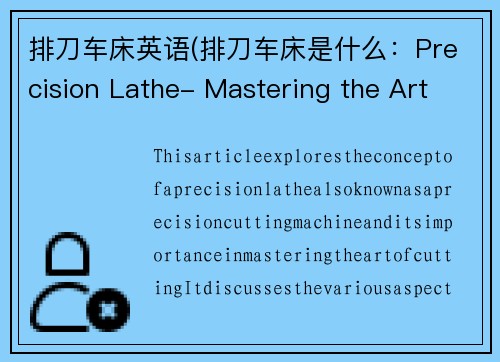排刀车床英语(排刀车床是什么:Precision Lathe- Mastering the Art of Cutting)
This article explores the concept of a precision lathe, also known as a precision cutting machine, and its importance in mastering the art of cutting. It discusses the various aspects of a precision lathe, including its design, functionality, and applications. The article emphasizes the significance of precision in cutting and highlights the role of a precision lathe in achieving accurate and high-quality results. Additionally, it touches upon the skills required to operate a precision lathe effectively and the benefits it offers in various industries.
Introduction
A precision lathe, also referred to as a precision cutting machine, is a specialized tool used in metalworking and woodworking industries. It is designed to perform precise cutting, shaping, and drilling operations on various materials. The precision lathe plays a crucial role in achieving accurate and high-quality results, making it an essential tool for craftsmen and manufacturers alike.
Design and Functionality
Precision lathes are typically compact in size and feature a sturdy construction to ensure stability during operation. They consist of a bed, headstock, tailstock, and a cutting tool. The bed provides a stable base for the lathe, while the headstock holds the workpiece and rotates it at different speeds. The tailstock supports the other end of the workpiece and can be adjusted to align it accurately. The cutting tool, often a single-point cutting tool, is used to remove material from the workpiece and shape it as desired.
The precision lathe operates by rotating the workpiece against the cutting tool, allowing for precise cutting and shaping. It offers various speed settings to accommodate different materials and cutting requirements. The cutting tool can be adjusted to achieve different depths and angles, enabling craftsmen to create intricate designs with precision.

Applications
Precision lathes find applications in various industries, including metalworking, woodworking, and manufacturing. They are used to create intricate designs on metal and wood surfaces, such as decorative patterns, threads, and grooves. Precision lathes are also utilized in the production of precision components for machinery, such as gears, shafts, and cylinders. Additionally, they play a vital role in the fabrication of prototypes and the repair and maintenance of existing parts.
J9九游会The Importance of Precision
Precision is crucial in cutting operations as it ensures accurate and consistent results. A slight deviation from the desired measurements can lead to faulty parts or products. Precision lathes enable craftsmen to achieve the required accuracy, resulting in high-quality end products. They allow for precise control over cutting parameters, such as depth, diameter, and shape, ensuring that the final product meets the desired specifications.
Skills Required for Operating a Precision Lathe
Operating a precision lathe requires a certain level of skill and expertise. Operators must have a thorough understanding of the machine's functionality, including its controls and adjustments. They should be able to interpret technical drawings and measurements accurately. Additionally, they must possess good hand-eye coordination and manual dexterity to handle the cutting tool and workpiece effectively. Regular maintenance and proper tooling techniques are also essential to ensure optimal performance and longevity of the precision lathe.
Benefits in Various Industries
The use of precision lathes offers several benefits in various industries. In manufacturing, precision lathes enable mass production of high-quality components with consistent accuracy. In woodworking, they allow craftsmen to create intricate designs and achieve precise cuts, resulting in finely crafted furniture and decorative items. In metalworking, precision lathes are essential for producing precise threads, gears, and other components used in machinery. Overall, the use of precision lathes enhances productivity, reduces material wastage, and ensures the production of superior quality products.
Conclusion
Precision lathes play a crucial role in mastering the art of cutting. Their design and functionality enable craftsmen to achieve accurate and high-quality results. Precision lathes find applications in various industries, offering benefits such as increased productivity and superior product quality. However, operating a precision lathe requires skill and expertise. By mastering the use of precision lathes, craftsmen and manufacturers can unlock their full potential and create intricate designs with precision and finesse.